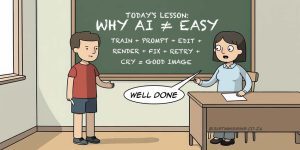These Photos Aren’t Real… And That’s Exactly the Point.
I rendered my friends into a series of black-and-white portraits that look straight out of a fashion campaign.
No camera. No lighting setup. No styling. Everything was generated on my machine, and I didn’t touch Photoshop at all. What you’re seeing is exactly how it came “out of the oven.”
They were rendered directly in black and white (not colour images converted afterwards). I went with that look on purpose. Colour can sometimes flatten the details or distract from the lighting and texture. If you’re viewing this on your phone, you’re probably missing some of the contrast and finer structure. These were meant to be seen full screen.
Each image took about 1 minute to generate. But getting to that point took time.
It’s kind of like saying a soufflé only took 15 minutes to bake. Sure… after two weeks of shopping, prepping, measuring, cleaning, Googling “why did it collapse” and redoing the whole thing twice. So yeah, it took me two weeks and a mild existential crisis.
This specific workflow took time to build. Training someone’s face properly takes hours. I usually need 30 to 60 reference images, and not just random selfies. Each one is cropped, cleaned up, and prepped so the AI understands how their face works from different angles.
That method gives me full control. I can direct the pose, the mood, the lighting, just like a real photoshoot, but without a camera.
There are many methods for making images like this, but I had to go the long route to get these results. I enjoy spending hours experimenting, training models, building custom ComfyUI nodes, implementing small fixes, breaking things, fixing them again, and refining the tools until they do what I want. It’s a mix of creativity and puzzle-solving, and I’m completely hooked on it.
I’m not a fan of the “one-click” trends like the ChatGPT action figure craze or the Ghibli filters. They’re everywhere now. Easy to do, and they all end up looking the same. If something’s too easy, it usually shows. I’d rather build something unique that reflects effort and understanding, not just novelty.
After making things like this for friends, I often get asked if real photographers will still be needed in the future.
Well, I’d say it depends on how far in the future you’re talking about. Let’s say you’re at a wedding. Everyone’s taking photos from different angles. The lighting’s inconsistent, people are blinking, and the backdrop’s a mess. Classic chaos.
Now, imagine an AI tool quietly running in the background. It gathers all those shots, blends them, corrects the lighting, picks the best expressions, swaps out that awkward table in the background, and rebuilds the scene for a cleaner, sharper version that somehow feels more “real” than anything you captured. You didn’t take the perfect photo, you just took enough. The tool handled the rest.
So what does that mean for photographers?
I don’t think AI will take photographers’ jobs just yet, but photographers who use AI will.




















 About the Author
About the Author

